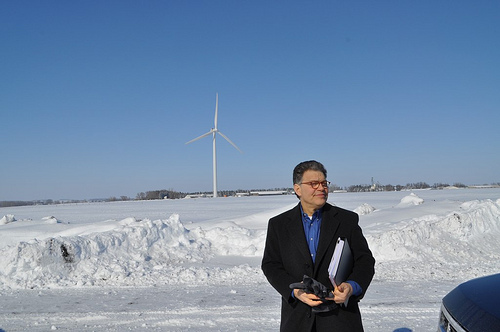Sen. Franken Launches New Job-Creating Energy Efficiency Initiative

Sen. Franken's Op-Ed on renewable energy in the Star Tribune.
Franken: In energy use, less is more -- much more
When Scott County partnered with Honeywell to upgrade insulation, lighting, windows and energy-management systems in six government buildings, everybody won.
Honeywell earned another customer in its continuing push to grow the clean-energy industry here in Minnesota. The construction and manufacturing sectors got a boost. Building-trades workers -- hit hardest by the recession -- were put back on the job. Future energy use was significantly reduced, leading to less impact on our environment. And Scott County taxpayers are saving more than $185,000 a year in energy costs.
That's what retrofitting is all about. Making our buildings more energy-efficient protects our environment, saves money, improves real-estate values, creates jobs -- and could be the next big thing for Minnesota's economy, with energy-service companies, leading windowmakers and other manufacturers headquartered right here in our state.
Unfortunately, financial and regulatory obstacles have made it hard for many governments and businesses to launch retrofitting projects of their own. Budgets are tight in both the public and private sectors, and many building owners have trouble finding capital for even a safe and smart investment like retrofitting. And lenders, new to the idea, are just now figuring out how to finance such projects.
But retrofitting is too good a deal to pass up. Local officials don't have to hope that the investment pays off; they can look to success stories from around the country and know that they'll make that money back and more while giving the economy a boost and creating jobs. Companies like Honeywell and Johnson Controls, for example, are willing to guarantee energy savings from retrofitting, meaning that the risk is about as low as you can get, and the rewards are huge.
I'm excited that local and state government leaders here in Minnesota are at the forefront of attacking obstacles to retrofitting. Gov. Mark Dayton has mandated increased energy efficiency in government buildings and is streamlining the process. Our Conservation Improvement Program, which sets aggressive energy-savings goals for utilities across the state, has also helped to kick-start demand.
And cities across Minnesota have worked with energy-services companies to retrofit their public buildings. But nationally, we're leaving some $80 billion on the table in potential work that could be done in municipal, school, university and hospital buildings.
Getting retrofitting projects off the ground has proven even more difficult for the private sector. Unlike municipalities, companies don't always own their own buildings, and when they do, they buy and sell them more frequently than governments do public buildings. Meanwhile, many commercial projects are small enough that they get overlooked by lenders, making it difficult to find financing.
We have all the ingredients to make Minnesota the leader in retrofitting: energy-service companies to guarantee savings, manufacturers to make energy-efficient products, workers ready to install them, lenders who could provide the financing, building owners eager to get these energy savings, and leaders in both the public and private sectors who understand what a big win this would be for our state.
Now we have to bring these stakeholders together to help them overcome the obstacles, get these projects up and running, and give our economy this critical boost.
That's why leaders from Minnesota and across the country are coming together in St. Paul today to kick off "Back to Work Minnesota," my initiative to create jobs through retrofitting. In partnership with Minnesota's cities and counties, the Minnesota Energy Jobs Association, and national organizations like the Clinton Foundation, I'm convening a kickoff meeting to address the challenges and realize the benefits of retrofitting.
We'll talk about eliminating the bottlenecks that stand in the way of retrofitting, the challenges of finding financing for these projects in a tough economy, the unique products and services that Minnesota companies have to offer, the success stories that stand as examples of what retrofitting can achieve, and the challenges that stakeholders face in following them.
I'm ready to work with Minnesota companies and civic leaders to knock down barriers to retrofitting and, if needed, to work toward federal legislation that will unlock its potential for our state.
Each city, county, business and university that invests in a retrofitting project makes it easier for others to follow in its footsteps. But it starts with bringing stakeholders together to work through the roadblocks to retrofitting. Today's meeting is an important step.
